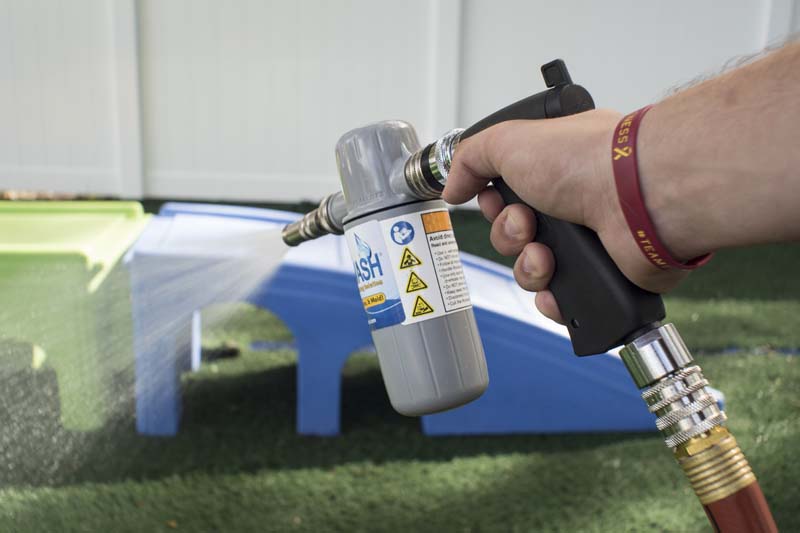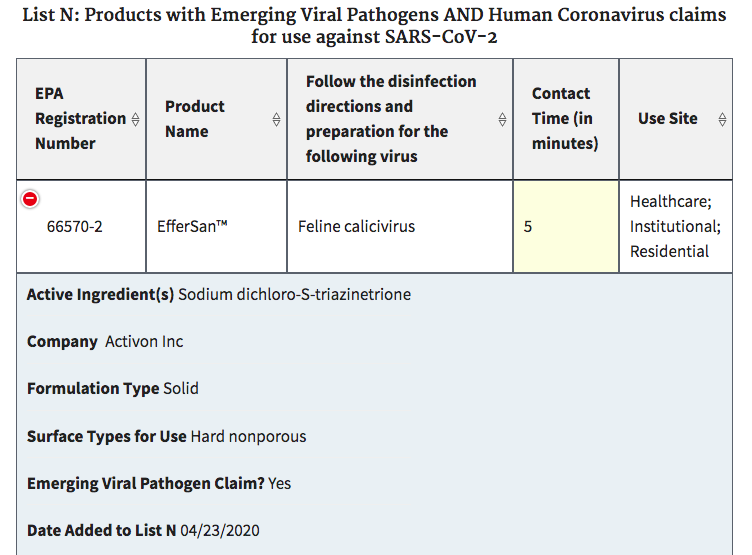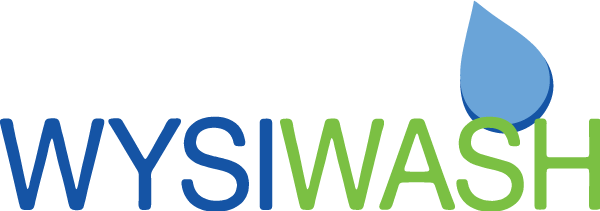How To Disinfect and Sanitize Coronavirus Using Wysiwash

With the appearance of this new form of coronavirus (COVID-19), there are a lot of questions arising about how to properly sanitize and clean common areas.
In this article, we’re going to explain a little bit more about the current state of the coronavirus (as of March 2020) and dive into answering some common questions we’ve been receiving here at Wysiwash.
The Coronavirus and COVID-19
Currently, not much is known about COVID-19, but we have done our best to collect the most up-to-date information from reliable health organizations. Some of this information may change, and we will do our best to update this article as more becomes known.
Though much of this article will focus on sanitation and cleaning for the Coronavirus, we want to stress that current evidence indicates that COVID-19 spreads primarily through person-to-person contact.2
While contact with the virus on surfaces is thought to play a lesser role in spreading COVID-19, sanitation is still an important part of disease prevention.
Now, onto the questions!
What are best practices for sanitizing/cleaning to prevent COVID-19?
There are several steps to preventing any bacteria, virus, or pathogens from developing.
Frequency
A well-sanitized area requires daily, weekly, and monthly cleaning. It’s important to be consistently dedicated to creating a clean environment, either in your home, business, or community. The time required for cleaning will vary depending on the size and exposure of your area. Regardless, staying on top of your cleaning schedule will help prevent the need for a cleaning overhaul.
Thoroughness
It’s important to put great care and attention into your cleaning practices. If you are not thorough while sanitizing, then bacteria can maintain in missed areas. One way to make thorough sanitization easier is to prioritize easy-to-clean materials.
Fact: Did you know that sanitizers are designed to attack organic compounds? That means that sanitizers can bond to cotton, an organic matter. Be sure to stay away from using cotton towels or mops when cleaning. Instead, use microfiber or polyester materials for the most thorough clean!
Following Directions
When using any cleaning product, you should be aware of the directions. Creating a cleaning product involves chemically active ingredients that sanitize in different ways depending on the manufacturer. In order to sanitize correctly and prevent the spread of any virus or bacteria, you must allow full contact time and follow the directions.
How long can COVID-19 live on objects?
UPDATE March 20, 2020: The New England Journal of Medicine published new research on how long SARS-CoV-2 can survive on surfaces and in the air. This study found that COVID-19 remained viable (meaning that it was alive and capable of transmitting the virus) for up to 72 hours on plastic and steel. When researchers tested cardboard, no viable viruses remained after 24 hours. On all surfaces, the amount of viable virus decreased over time.
Their experiments also indicated that COVID-19 can survive in the air for at least 3 hours. However, the amount of viable virus decreased sharply over time. It is important to note that this study was done in ideal conditions. More research is needed to see how the virus behaves in real world settings where heat, humidity, UV exposure, and other environmental factors may impact how long aerosolized droplets remain viable.
Original Answer: As of the writing of this article, it is unclear how long COVID-19 lives on surfaces. However, we can make inferences about COVID-19 from other strains of coronavirus and other enveloped viruses, such as influenza.
Similar enveloped viruses to COVID-19 live longest on hard, non-porous surfaces, such as plastic and metal. Based on this, experts say that COVID-19 lives longest on hard surfaces.
According to the CDC, "SARS-CoV-2 may remain viable for hours to days on surfaces made from a variety of materials."1 However, some research suggests that COVID-19 can live on surfaces for up to 9 days.4
Does Wysiwash kill coronavirus?
Although we do not hold a claim for COVID-19, per se, we can logically deduce efficacy based on the following information:
As an emerging, novel virus, germicides typically do not carry claims against COVID-19; however, the Wysiwash Sanitizing System has demonstrated excellent effectiveness on surfaces against bovine coronavirus, a virus very similar to COVID-19. Further, studies indicate that a 50 ppm sodium hypochlorite solution kills COVID-19 on hard surfaces in one minute or less.4 Wysiwash and Effersan are much more effective than a 50 ppm sodium hypochlorite solution.
Please refer to the CDC's website for additional information.
The COVID-19 is an enveloped virus, making it an easy-to-kill virus. Non-enveloped viruses such as canine parvovirus or feline calicivirus are much more difficult to destroy. Wysiwash and Effersan have both demonstrated excellent effectiveness on those two non-enveloped viruses as well. It is important to follow directions and treat surfaces thoroughly to maximize effectiveness.
What is Wysiwash?
Wysiwash is a sanitizing and disinfecting solution that delivers safe, accurate concentrations of chlorine-based sanitizer. This mild, yet highly effective cleaning solution has been trusted by various industry professionals, such as animal kennel owners, for over 15 years.
What makes Wysiwash unique?
The Solution
Each Wysiwash Jacketed Caplet contains a highly compressed calcium hypochlorite solution that is more effective and economical to use than liquid bleach. Hypochlorous acid, which is contained in chlorine, is the key sanitizing agent used in the Wysiwash Sanitizing System.
Hypochlorous acid is effective against the most dangerous pathogens including bacteria, viruses, fungi (such as ringworm) and protozoa.
The Kit
Scientifically designed to accurately deliver consistent levels of active chlorine, Wysiwash is way more than a hose-end sprayer. It is a precisely calibrated sanitizing and disinfecting instrument. Learn more about the Wysiwash Sanitizing System here.
The Effectiveness
No more mixing chemicals, lugging heavy buckets around, or waiting for long contact times. Wysiwash is a clean and biodegradable product. In fact, the main ingredient, calcium hypochlorite, is commonly used in public swimming pools and to disinfect drinking water.
What everyday sanitizing products do you recommend?
With COVID-19, we mention Wysiwash because it’s a sanitizing solution for large public areas, which is the cause for concern with the coronavirus. However, we realize that sanitizing everyday, in-home products are just as important to preventing a virus.
For disinfecting countertops and surfaces, we recommend Effersan. It's an EPA Registered disinfecting and sanitizing tablet that can be dissolved in water to be used as a spraying solution. Effersan tackles sanitizing 99.999% of bacteria in 1 minute! Plus, this product also doubles as a deodorizer that features tablets for fabrics while laundry washing.
EfferSan has qualified to meet the EPA Emerging Viral Pathogen Guidance for Antimicrobial Pesticides against SARS-CoV-2, the novel coronavirus that causes COVID-19 (COVID-19). EfferSan's demonstrated efficacy on a wide range of pathogens is further confirmed by the addition to the EPA List N and will update its stamped label with Emerging Pathogens language as soon as possible. (You can find EfferSan's entry by searching EPA List N by its EPA registration number: 66570-2.)

How does Effersan work, you might ask?
Effersan's active ingredients are within the chlorine family, however Effersan is formulated as a pure sanitizing and disinfecting agent. Unlike liquid bleach and other conventional cleaning products, Effersan has no additives or stabilizers, which makes it safer for people, pets, and the environment. Although safe, Effersan is also extremely effective. It has been tested and shown effective against the norovirus, RSV, H1N1, Trichophyton mentagrophytes (common cause of Athlete’s Foot), salmonella enterica, and many more.
Do I need to change my cleaning protocols in response to this outbreak?
During flu season, it’s always smart to sanitize high-contact surfaces more often than normal. This is especially true in places where people gather, like offices, schools, transportation hubs, and shopping centers.
If you run a school or you're an administrator of another place where people come and go frequently, you should already have a daily sanitizing routine for frequently touched surfaces and objects. If you do not, then it is not too late to develop one.
Wysiwash is great for sanitizing large surfaces, like playgrounds, gym mats, and locker rooms. Because cleaning them can be such a daunting task, these surfaces are often overlooked. Adding Wysiwash to your cleaning protocols makes cleaning these large areas a snap, which is why many schools and daycare centers use Wysiwash to sanitize play equipment.
Do I need to worry about catching COVID from my dog or cat?
UPDATE MARCH 20, 2020: According to the WHO (World Health Organization), "While there has been one instance of a dog being infected in Hong Kong, to date, there is no evidence that a dog, cat or any pet can transmit COVID-19. COVID-19 is mainly spread through droplets produced when an infected person coughs, sneezes, or speaks. To protect yourself, clean your hands frequently and thoroughly."3
There is a lot unknown about this particular case, but it has been widely reported that the dog's owner contracted and recovered from coronavirus. Tragically, it appears that the dog caught it from their owner. The CDC currently advises, "If you are sick with COVID-19 (either suspected or confirmed), you should restrict contact with pets and other animals, just like you would around other people." 5
Conclusion
Although the beginning of 2020 has brought unique attention to the world of sanitizing products, Wysiwash has been providing safe and effective products for years. If you want to learn more about our products, please visit our quick start guides.
